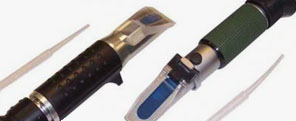 |
|||||||
|
The life blood of any machining operation is its coolant / lubrication system. The coolant/ lubricant mixture that feeds the machining operation is stored in a sump, or reservoir, from which the lubricant is drawn. Groups of machines may be configured to draw lubricant from a central sump or system. Modern metalworking synthetic or semi-synthetic coolants are mixtures of water and an assortment of chemical additives including oils, emulsifiers, rust inhibitors and biocides. Just as a doctor might draw blood from a patient diagnosis, a coolant analyst draws a sample of in-service coolant to analyze its contents and how they have changed with time. Coolant Change with Time When a sump is charged with coolant, the coolant mixture is obtained from mixing a concentrate with water. As a machine works, the proportions of its chemical components change. In particular, the amount of emulsifiers, rust preventatives and biocides decrease with lube use and over time. Contrastingly, the amount of dissolved solids in the lubricant increases over time, as does the level of oil content and fluid alkalinity. These changes can cause a pronounced effect on the relative proportions of lube concentrate and other formula ingredients which, in turn, can have a drastic effect on machinery performance. Concentration Is Everything Similarly, if the concentration is insufficient, lubrication and tool life could be adversely impacted. The life of the fluid itself will be shortened and the performance of the rust inhibitors and biocides will be compromised. Consequently, it makes sense to check your coolant fluids often to correct any chemical deficiencies. In some operations this means daily checks and adjustments are critical to efficient and safe lubrication. The size of your system and machine running time determine how much fluid adjustment is needed for best performance. For a sump serving a single machine, a few ounces of lube concentrate may bring the entire fluid into specification; for a central system, a gallon or more may be needed.
A simple instrument, the optical refractometer, is based on the Gladstone-Dale principle of fluid optics, and is the most common and effective concentration control instrument. An optical refractometer measures the light-bending characteristics of fluids. For water-based fluids, higher concentrations increase the angle of light that is bent as it passes through the fluid. By measuring the bending of light, you can calculate fluid concentrations and, in so doing, the correct dilution can be maintained and you will get the best possible performance from the lube product and the machinery it lubricates. The advantages of using a refractometer are its portability, low cost to purchase and maintain, ease of operability, instant results and versatility for nearly all water-based fluids. The instrument also has its drawbacks in that it measures the refractive index of the total solution, not just a single component. Therefore, refractometer readings can be inaccurate when the system uses hard water with a high mineral content or when tramp oil is present. It is important to frequently recalibrate the refractometer using shop water. Trouble Concentrating? Our highly trained specialists can help you select the fluids you need and help you keep them in the right proportions. (They can even supply you with the refractometer.)
|

|
||||||
|
|||||||
|
|||||||
Accurate Lubricants & Metalworking Fluids, Inc.• 403 Homestead Avenue; Dayton, Ohio 45417 USA • Phone: 937-461-9906 Fax: 937-461-9917
|
|||||||
